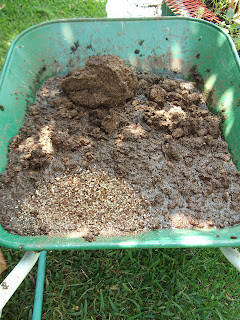After reading this tip in a garden magazine I decided to repurpose them as plant holders. It only takes a few items to put these together, and most of them will be things that you have on hand.
Potting soil or some other soil medium
old outdoor lights
succulants, cactus or other low care plants
If you have a lot of time on your hands you could clean these up and/or paint them, but I just wiped the lights clean.
I removed the bulbs from inside the lights. Many home improvement stores, including Home Depot, will let you drop off your light bulbs and batteries so please don't send these to the landfill.
My peat moss was one big rock so the bulk of my time went to breaking it up into useable pieces.
I added a little vermiculite for extra drainage and filled my little pots with soil.
I had a few pots of succulants on hand but most dollar stores have pots of cactus and succulants if you need something quick & cheap. A hole in the center helps save the roots when planting.
Push the plants in the soil, pressing the soil firmly around the roots.
Push the stems of the lights in the soil and enjoy your designer pots!
Be well and Happy Gardening!














































